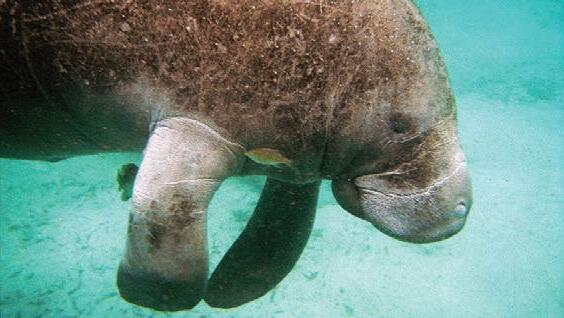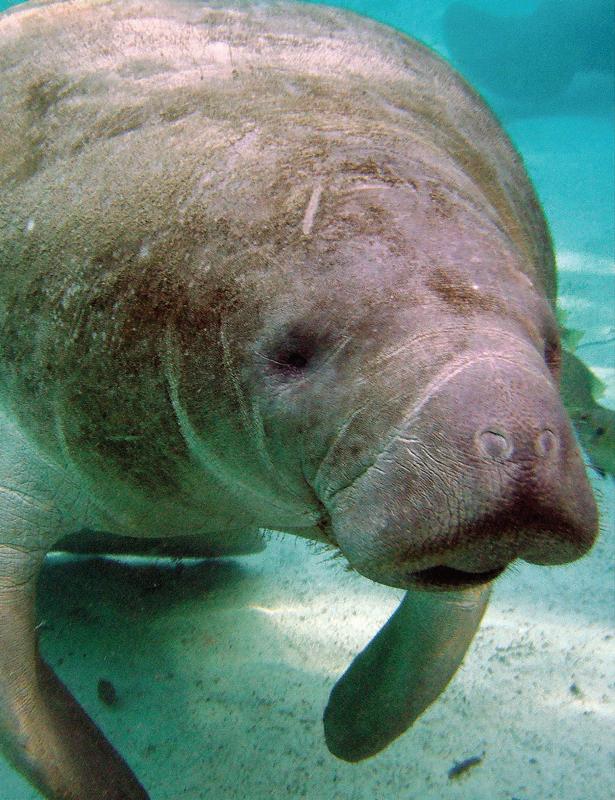
7 minute read
Getting to Know Manatees
Above: Swimming together, possibly a mother and calf pair. Photo by Sam Farkas, 2014 NOAA OAR photo contest winner Below: Definitely not a mermaid, but much cuter in our opinion. Photo by Emily J. McDaniel, Imbued Photography
By Neva Parsons Assistant Editor
Advertisement
Florida manatees visit our coastal waters when water temperatures begin to warm and it's always a thrill to catch a glimpse of one. In this feature we'll learn about manatee senses, share some fun trivia, and learn how you can help these protected mammals.

Aman would have to be three sheets to the wind to see any resemblance between a sea cow – otherwise known as a manatee – and a beautiful young woman with flowing locks and a fish’s tail. But there’s speculation that these gentle, shy, herbivorous creatures may have been mistaken for mermaids in the old days of sail. Even Christopher Columbus noted three “mermaids” off the coast of Haiti, but was disappointed that their faces had “some masculine traits” and so were not as lovely as had been rumored. It must have been the whiskers.
But the very obvious facial whiskers are only the beginning of this hairy tale. Manatees sport tiny hairs all over their bodies known as vibrissae. The dictionary definition of vissibrae is “hairs growing around the mouth or elsewhere … used as organs of touch.” Much as a cat uses its whiskers to process sensory input from its environment, a manatee uses all that fine body hair to compensate for its poor eyesight in low-light waters, or at night. A study conducted at the Mote Marine Laboratory, in Florida, indicates the hairs are hypersensitive and able to detect vibrations as low as one-millionth of a meter. And all this without external ear lobes!
• Manatees don't have eyelashes! • Manatees can live for more than 60 years. • Newborn calves can swim to the surface on their own and begin vocalizing at, or right after birth. • The gestation period (pregnancy) is about a year, and mother manatees nurse their calves for one to two years. • Manatees and sloths only have six neck vertebrae - all other mammals have seven. Manatees also can't turn their heads. They have to turn their whole bodies around. • Mature manatees average about 10 feet long and weigh from 800 - 1200 pounds.
Right: Manatees often have barnacles, algae and other marine growth on their bodies. Below: Very social animals, they are often found in groups. Photos this page by Emily J. McDaniel, Imbued Photography



The manatee’s eyesight is no great shakes, but what about its hearing? Surprisingly, quite good. In fact, they can hear sounds much higher than humans. Homo sapiens clock in at 20 hertz to 20 kilohertz, while the manatee boasts an ability to detect frequencies in the 90.5 kilohertz range. One obvious question is, if they hear so well, why do they seem to have difficulty in avoiding boat engines and propellers, which can inflict terrible injuries? Another Mote Marine study suggests they’re not so different from us humans. As we go about our days – working, eating, supervising and protecting children, socializing or napping – we’re simply less aware. Sounds fade into background noise, and if we’re unlucky, we respond too slowly to a threat. This is why it’s very important for boaters to abide by low-speed and no-wake zones, particularly around docks where manatees may be munching on an algae snack, and to watch closely for these slow-moving creatures while at speed.
Let’s continue examining the manatee’s senses. Next up is communication. How do cows chastise their calves when they won’t settle down and eat their sea grass? How do bulls flirt with that pretty cow decked out in the most exquisite barnacles? How do they recommend the best places for a good water hyacinth sandwich? Much the same way that whales vocalize, with squeaks, chirps, squeals, whistles and the occasional grunt. Unlike whales, however, their vocalizations aren’t used for navigation or as a sort of sonar. Instead, manatees chat about the everyday happenings around them. There are recordings of manatee conversations online if you want to give a listen. Just don’t expect the eerily beautiful singing of the sirens of Greek mythology, despite the manatee being a member of the order Sirenia.
Finishing up with taste and smell. As with humans and other mammals, manatees have chemical receptors for taste and smell, right next door to each other. And, like humans, they’re able to determine whether what they’re about to have for dinner has gone bad, or has been tampered with. One last fun fact relates to another definition of smell, as in, shall we say, flatulence? It seems there’s some evidence manatees use their flatulence, not to clear a room, but to control buoyancy. Whales and other fish have swim bladders to do that work, which mammalian manatees lack. Hey, whatever works, am I right? Again, if you’re interested, there are online videos of manatees … controlling their buoyancy. Don’t say I didn’t warn you.
That’s our tour of the manatee senses. So the next time you have one too many out on the water and find yourself face to face with a bewhiskered, near-sighted mermaid with a bad singing voice and an issue with intestinal gas, it might be nothing more than a sweet manatee popping up to say hello.
For more information about manatees and how you can help them, please visit: www.savethemanatee.org

This page top: Close-up of a manatee's face from the side. This page left: The picture that should be in the dictionary next to the definition for "Cute." Opposite page: That looks like someone we know ... Photos by Emily J. McDaniel, Imbued Photography
• Manatees are sirenians (an order of fully aquatic, hervbiverous mammals), and are most closely related to elephants. It’s thought that more than 50 million years ago, manatees and elephants evolved from a common land animal. • There are three types of manatees: West Indian, Amazonian and African, with the West Indian being the largest. The Florida manatee, found in Georgia waters in spring and summer, is a subspecies of the West Indian, formally known as Trichechus manatus. • Manatees, like whales, communicate by emitting a wide variety of squeaks, whistles and chirps, as well as though sight, taste, touch and smell. Unlike whales, however, these vocalizations aren’t thought to be used for navigation. • Manatees may eat 10-15% of their body weight each day as they graze on sea grass, algae and mangrove leaves. But their roly-poly appearance isn’t the result of fatty insulation – it’s due to the fact that their stomach and intestines compose the bulk of their bodies. • Manatees stray back and forth over the line between fresh and salt water. While they need freshwater, their kidneys work to keep salt concentrations in their body at a safe level.

Manatee Safety Tips:
• Look for manatees before cranking your boat’s motor. • Use caution when navigating in shallow water and along the edge of a marsh. Manatees cannot dive away from boats in these areas. • If you see one manatee, slow down, they are social animals and others may be present. • Heed “slow speed,” “no wake” and manatee warning signs, especially around docks. • Wear polarized sunglasses to reduce glare and make it easier to spot manatees below the surface. • Watch for trails of large swirls in the water called footprints that may be caused by manatees diving away from the boat. • Never feed manatees or give them fresh water. This could teach the animals to approach docks, putting them at greater risk of a boat strike. • Never pursue, harass or play with manatees. It can be harmful to manatees and it’s illegal. • If you see or photograph a healthy, injured or dead manatee, call DNR at (800) 2-SAVEME (800-272-8363). Note the date, time, location and number of manatees seen, plus the coordinates, if possible.










